Behavioural Ecology of Columbian Ground Squirrels
Research Cluster: Animal Ecology
Project Coordinator(s): Vincent A Viblanc, Institut Pluridisciplinaire Hubert Curien, CNRS, Strasbourg, France; F. Stephen Dobson, Auburn University, USA; Jan O Murie, University of Alberta
Behavioural Ecology of Columbian Ground Squirrels: The Benefits of Family
Columbian ground squirrels (Urocitellus columbianus), often mistakenly referred to as gophers, are one of the most common mammals in the foothills of the Rocky Mountains. They are a sciurid rodent species (a family including tree squirrels, chipmunks, prairie dogs, marmots, and flying squirrels) with a short active season extending from mid-April to mid-August (Murie & Harris 1982). During the breeding season, Columbian grounds squirrels have quite an active social life!
Kin-based social behavior
The species is organized in so-called matrilineal societies, where females are philopatric and kin female overlap both in space (King 1989b) and through time (King & Murie 1985) (overlapping generations). Males on the other hand typically disperse out of natal groups as yearlings (Boag & Murie 1981; Wiggett & Boag 1989; Neuhaus 2006). During lactation, females are highly territorial, but appear to be discriminative of kin and non-kin individuals (King 1989a).
Studying female aggression over the course of a breeding season using a social network approach, we found that network measures characterizing received aggression (in-strength, in-degree) decreased as individuals aged, whereas network measures characterizing elicited aggression (out-strength, out-degree) peaked at prime reproductive age before decreasing in older individuals (Viblanc et al. 2016a). Further, accounting for age, network metrics of elicited aggression (grouped in a principal component) were positively related to female fitness (standardized estimate β = 0.32 ± 0.14, CI [0.04; 0.59]), especially for females with few kin (interaction effect; standardized estimate β = -0.34 ± 0.14, CI [-0.67; -0.01]). This result may potentially reflect lower levels of aggression for females with adjacent kin to achieve similar levels of fitness, consistent with the idea that kin provide a safe environment for raising offspring.
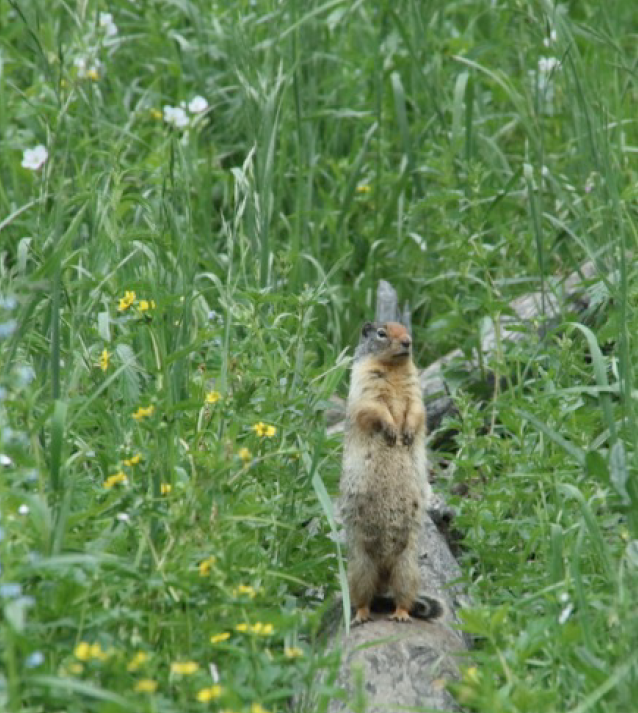
A Columbian ground squirrel scanning its environment above the tall grass, from atop a fallen tree.
Photo by VA Viblanc, Sheep River Provincial Park, Alberta, Canada.
Figure at right: Directed, weighted, social network of aggressions during lactation in Columbian ground squirrels (Urocitellus columbianus) (Image to right). Females are symbolized by circles, males by triangles. Kin individuals (regardless of sex or age) sharing the same mother are depicted by the same number. A directed aggression between 2 individuals is symbolized by an arrow pointing from the initiator toward the recipient. Arrows are weighted according to the number of aggressions exchanged. Breeding females are depicted in blue.
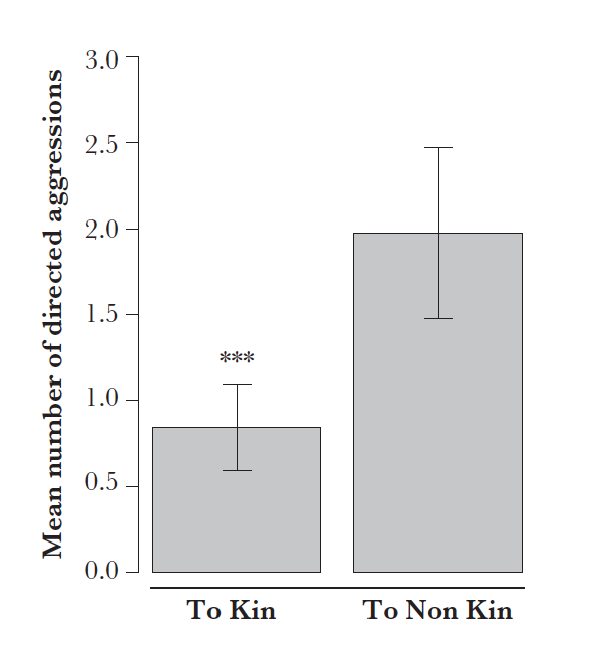
Figure above: Aggressions directed toward kin or non-kin within a social network of aggressions in Columbian ground squirrels (Urocitellus columbianus): the mean number of female–female aggressions directed to kin versus non-kin; ***P < 0.001.
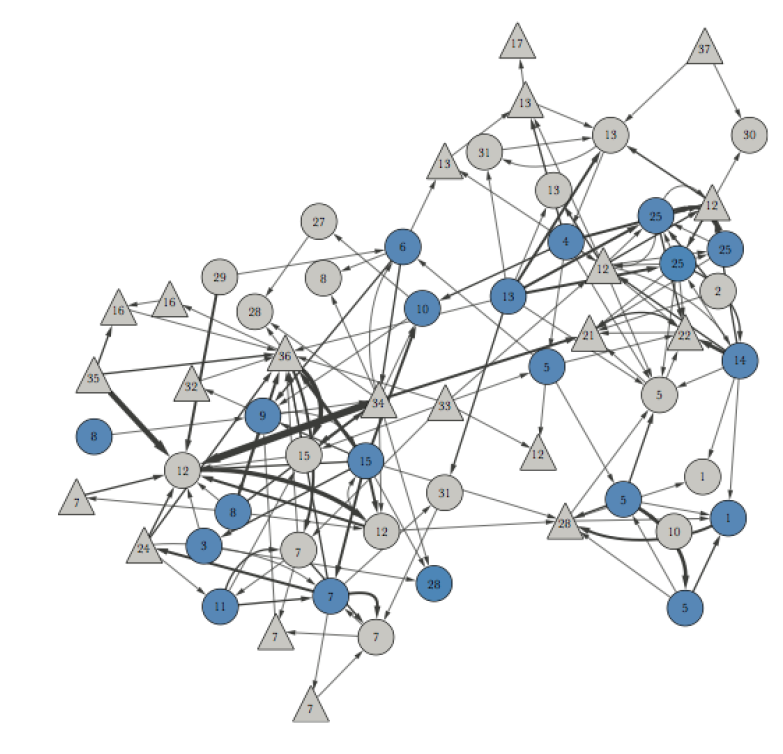
Consequences on energy allocation strategies
This highlights one of the benefits of female philopatry: genial neighbor benefits via differential aggressiveness towards kin could arise because of different risks of infanticide for pups (Stevens 1998), or could affect the amount of energy females can allocate to lactation vs. territorial defense, affecting their success at weaning. We tested this hypothesis by investigating the effect of female kin on energy allocation strategies over a 23-year period (Viblanc et al. 2016b). Controlling for female age, we found that for breeding mothers, the balance of energy allocated to somatic (growth, maintenance) vs. reproductive functions was significantly affected by her number of co-breeding kin. Mothers with more co-breeding kin significantly biased their allocation of energy towards offspring production (estimate = 8.35 ± 2.87 more grams of offspring for mothers with kin present; t = 2.91; P = 0.004, n = 359, N = 138), supporting the hypothesis that breeding females are able to allocate more energy into reproduction when kin are present. In turn, the increased energy allocation had positive effects on litter size at weaning and thus female fitness.
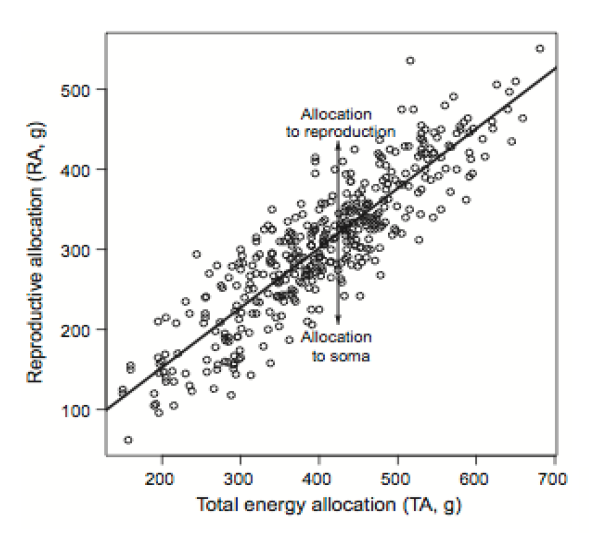
Figure at left: Relationship between reproductive (RA) and total (TA) allocation in female Columbian ground squirrels. Reproductive allocation is calculated as offspring mass gain from birth to weaning. Somatic allocation SA is calculated as female mass gain (in g) from emergence of hibernation to offspring weaning. Total allocation is the sum of reproductive and somatic allocations TA = SA + RA. Residuals from the regression line (residual RA) represent the balance of allocation between reproductive and somatic functions. Positive residuals represent higher allocation to reproduction than predicted for a given total allocation and negative residuals higher allocation to the soma.
Figure at right: Overall effect of co-breeding kin numbers on the balance between somatic and reproductive allocation (residual RA) in Colum- bian ground squirrels. Relative to the average population, positive values of residual RA (above the horizontal line) indicate an alloca- tion bias towards reproduction, whereas negative values (below the horizontal line) indicate an allocation bias towards the soma. The prediction is figured by a dashed line with its 95% confidence intervals. Kernel densities are figured for illustration purposes.
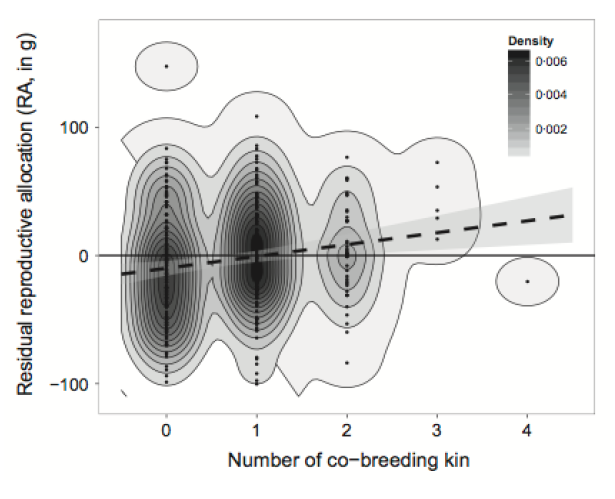
Consequences on female fitness
Indeed, in an integrative analysis where female reproduction was monitored throughout the entire life of 70 individual females, we examined the variance in female fitness and compared this with the average number of kin present for each female over her lifespan (Viblanc et al. 2010). Our analysis, a path model describing causal direct and indirect links relating individual kin to female fitness, revealed positive direct effects of kin on female fitness through enhanced litter sizes at weaning: female with higher close kin numbers (averaged per year) achieved higher fitness over their lifetime.
Going a step further, we evaluated the net benefits of the presence of kin on inclusive fitness, i.e. not only considering a female’s own reproduction, but also considering the reproduction of her close kin (mother, daughter and litter mate sisters) with whom she shares a certain proportion of her genes by common descent. Shared genes are important to fitness, since a portion of a female’s genes may be transmitted into future generations through the reproduction of close kin. In this study, we calculated direct fitness benefits of females with co-surviving adult close kin and compared it to the fitness benefits of females without such kin (Dobson et al. 2012). The fitness of females without co-surviving kin produced an estimate stripped of social benefits. This estimate could then be subtracted from the direct fitness of close kin to estimate the net fitness benefit of cooperation for both kin-related mothers. The indirect fitness component (about 40% of total fitness) was estimated by multiplying this value by the coefficient of relatedness and summing over close kin. This resulted in a substantial inclusive fitness increase for the ‘kin cooperation’ trait, which increased as the number of co-surviving kin increased.
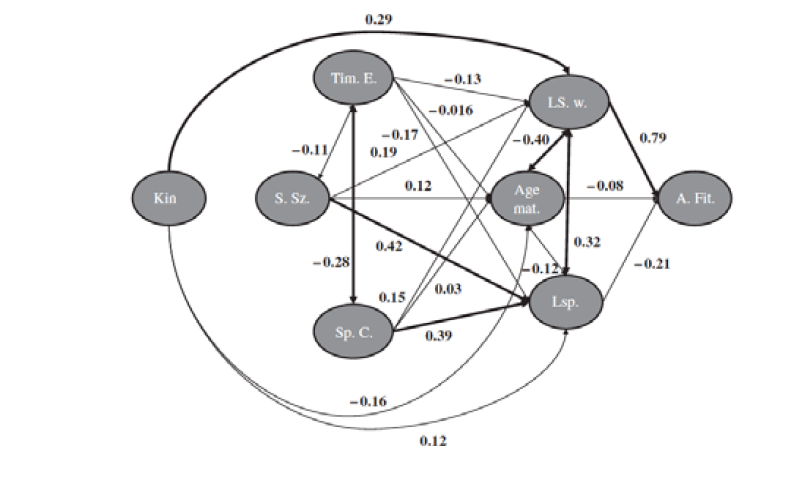
Figure at left: Influence of kinship on female fitness: overall path diagram with path coefficients. Variables: Kin, mean number of kin present over lifetime; Sp. C., mother’s spring body condition; S. Sz., mother’s structural size; Tim. E., timing of emergence; LS. w., litter size at weaning; Lsp., mother’s lifespan; Age mat., age at maturity; A. Fit., adjusted fitness. Significant paths (p < 0.05) appear in bold. Single headed arrows indicate causality, whereas double-headed arrows indicate correlations (n = 70).
Figure at right: Estimated inclusive fitness and number of co-surviving close kin (mother-daughter and littermate sister dyads) that were both of reproductive age (2 years old and older) and actively reproducing at the same time.
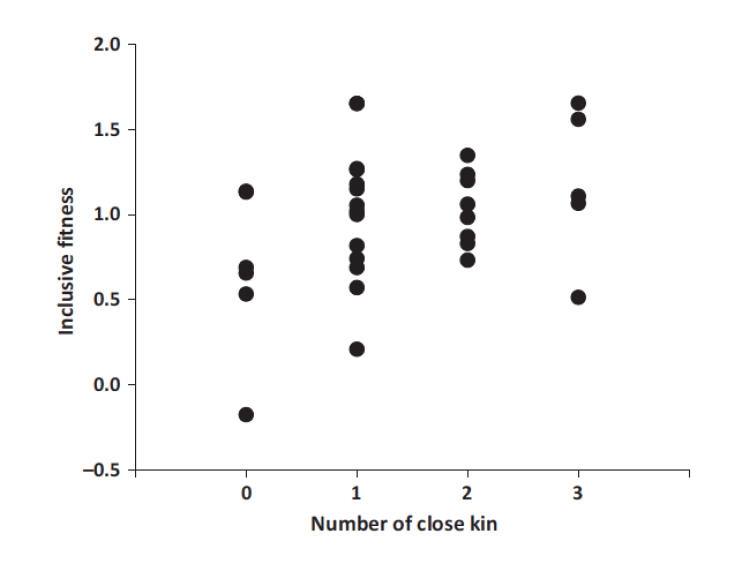
So where next?
We are now turning towards a more mechanistic approach, questioning the effects that social settings may have on individual physiology. Specifically, we are interested in understanding (1) whether kin individuals may act as a buffer to social stress; (2) the consequences of social aggression on adult stress, oxidative stress, and ageing; and (3) the consequences of different social rearing environments during lactation on the development of offspring. To do so, we are using a mix of different ecophysiological approaches, measuring glucocorticoid (stress) hormones, oxidative stress levels (Viblanc et al. 2018) and telomere length (DNA sequences that deteriorate both with age and experienced stressors) in individual females experiencing different social environments. We are combining those measures with a novel bio-logging approach to monitor social contacts between individuals both above and below-ground, using contact collars and 3D accelero-magnetometers.
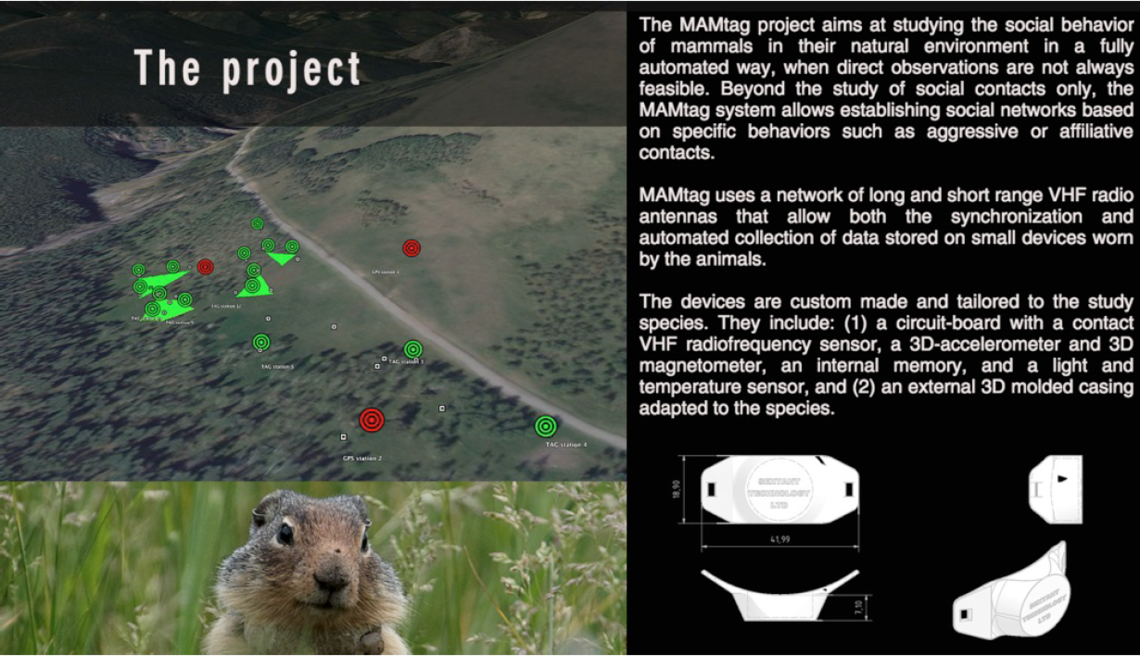
References
Boag, D.A. & Murie, J.O. (1981) Population ecology of Columbian ground squirrels in southwestern Alberta. Canadian Journal of Zoology, 59, 2230–2240.
Dobson, F.S., Viblanc, V.A., Arnaud, C.M. & Murie, J.O. (2012) Kin selection in Columbian ground squirrels: direct and indirect fitness benefits. Molecular Ecology, 21, 524–531.
King, W.J. (1989a) Kin-differential behaviour of adult female Columbian ground squirrels. Animal Behaviour, 38, 354–356.
King, W.J. (1989b) Spacing of female kin in Columbian ground squirrels ( Spermophilus columbianus ). Canadian Journal of Zoology, 67, 91–95.
King, W.J. & Murie, J.O. (1985) Temporal overlap of female kin in Columbian ground squirrels (Spermophilus columbianus). Behavioral Ecology and Sociobiology, 16, 337–341.
Murie, J.O. & Harris, M.A. (1982) Annual Variation of Spring Emergence and Breeding in Columbian Ground Squirrels (Spermophilus columbianus). Journal of Mammalogy, 63, 431–439.
Neuhaus, P. (2006) Causes and consequences of sex-biased dispersal in Columbian ground squirrel, Spermophilus columbianus. Behaviour, 143, 1013–1031.
Stevens, S.D. (1998) High incidence of infanticide by lactating females in a population of Columbian ground squirrels (Spermophilus columbianus). Canadian Journal of Zoology, 76, 1183–1187.
Viblanc, V.A., Arnaud, C.M., Dobson, F.S. & Murie, J.O. (2010) Kin selection in Columbian ground squirrels (Urocitellus columbianus): littermate kin provide individual fitness benefits. Proceedings of the Royal Society B: Biological Sciences, 277, 989–994.
Viblanc, V.A., Pasquaretta, C., Sueur, C., Boonstra, R. & Dobson, F.S. (2016a) Aggression in Columbian ground squirrels: relationships with age, kinship, energy allocation, and fitness. Behavioral Ecology.
Viblanc, V.A., Saraux, C., Murie, J.O.J.O. & Dobson, F.S.S. (2016b) Kin effects on energy allocation in group-living ground squirrels (ed S Griffith). Journal of Animal Ecology, 85, 1361–1369.
Viblanc, V.A., Schull, Q., Roth, J.D., Rabdeau, J., Saraux, C., Uhlrich, P., Criscuolo, F. & Dobson, F.S. (2018) Maternal oxidative stress and reproduction: Testing the constraint, cost and shielding hypotheses in a wild mammal. Functional Ecology.
Wiggett, D.R. & Boag, D.A. (1989) Intercolony natal dispersal in the Columbian ground squirrel. Canadian Journal of Zoology, 67, 42–50.
